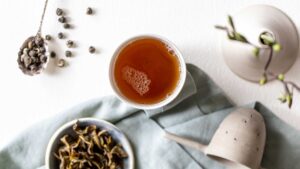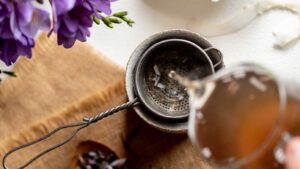How to prepare tea across cultures
“No matter where you are in the world, you are at home when tea is served.” – Earlene Grey (poet, tea enthusiast).
Across cultures, individuals from different walks of life prepare tea, drink and enjoy tea. For many, tea isn’t just a drink but a meaningful beverage that holds spiritual importance. Whether it’s enjoyed at a Japanese tea ceremony, at a tea leaf reading or simply at that time in the afternoon that’s completely yours – a good cup of tea enriches life.
As you sip on your own cup of tea, allow us to take you on a journey, exploring the curious and wonderful tea drinking habits around the world. With focus on the original tea regions – China, Japan and England – we hope you learn something new about your tea ritual.
Tea traditions
Tea is an ancient beverage that has passed through history, with the first record of the plant Camellia Sinensis founded in China in approximately 1500 BC – 1046 BC during the Shang Dynasty when tea was consumed as a medicinal beverage. When tea drinkers discovered that tea is not only medicinal but tastes great, popularity grew rapidly.
Since its cultivation, tea has spread far and wide to Japan, England, India, Sri Lanka, Africa and the world. As tea has grown, so too have the many traditions. As you read, think of how you prepare tea and what traditions you might have.
Chinese tea culture
According to Chinese legend, over 5,000 years ago Emperor Shen Nung was sitting under a tree enjoying a cup of hot water. A gust of wind blew, blowing several leaves into his hot water. A pleasant aroma floated from his cup. Curious, Emperor Shen Nung took a sip of his brew and what he discovered was a delightful sensory experience that healed and comforted.
This legend, whether true or not, played an important role in tea’s purpose in Chinese society. In 200 B.C. the Han Dynasty Emperor ruled that when referring to tea, a special written character must be used. The character displays wooden branches, grass, and a man between the two. This character (pronounced “ch’a”) symbolises the way tea brought humankind into balance with nature for Chinese culture.
Chinese tea houses
From its discovery to present day, China has celebrated tea with tea houses. Here is where people drink tea, relax and enjoy entertainment. Spread across cities and villages, tea houses are vivid representations of China’s love for tea, bringing together friends, family and colleagues to enjoy a pot of tea.
Tea has become synonymous with China, and China with tea. If you’re ever travelling the country, a visit to a tea house is a must.
Gongfu tea ceremony
Tea is prepared with skill. In fact, the Chinese tea ceremony gongfu tea ceremony translates exactly to “making tea with skill.” This process of brewing tea involves intention and patience, using smaller brewing vessels and a higher leaf-to-water ratio than in western-style brewing.
Tea (often green tea) is brewed to an exact time, water temperature setting and ratio (depending on the tea leaves). Poured from a small pot and into a small ceramic cup. The small pot is chosen specifically to enhance the steep time whilst the small cup allows the tea to cool quicker.
Once the tea has been prepared and guests have taken a sip of their cup of tea, drinkers will often thank the tea maker by tapping their finger on the table or the tea cup three times.
Japan
“Tea and Zen are one.” – Musō Soseki (Zen Buddhist monk and teacher).
Tea in Japan dates as far back as the 8th century when Japanese Buddhist monks were sent to China to learn about the country’s culture. What peaked their interest was the delicious green tea leaves enjoyed at the Chinese tea houses. The Buddhist monks brought the green tea leaves back to Japan, drinking tea to keep them awake during meditations.
When the monks served a cup of tea to Emperor Saga, the Emperor was instantly impressed. Saga grew a strong liking to a pot of tea and encouraged tea cultivation throughout Japan. The Emperor enjoyed tea so much that he often wrote poetry about the perfect cup of tea.
Although adored by the Emperor and the monks, tea at this time was reserved for the elite. It wasn’t until the 12th century that tea consumption became popular outside of these noble circles.
Japanese chadō
The Japanese tea ceremony or Japanese chadō or sadō (“way of tea”) or cha-no-yu (“hot-water tea”) dates back thousands of years in history.
The Buddhist monks Kūkai and Saichō who originally visited China and brought back the tea leaves, incorporated their tea making into a mindful ritual. This ritual became to be known as the Japanese tea ceremony, an important ritual to serve as a way of appreciating the beauty in the daily routine of life.
Modern day Japanese tea ceremonies commonly follow a similar pattern. Guests enter the room, often having to kneel or crawl through a tight hallway (a ritual popularised by Kūkai). The host will bring into the room the tea and utensils. The tea is then made carefully in front of the guests, often pulverised tea leaves stirred in hot water.
It’s important that tea is enjoyed together, in harmony, with respect and cleanliness and amongst tranquillity, nodding to its original roots in Buddhist meditations.
Japanese powdered tea
Matcha was first created by Buddhist monks who made the powdered tea from steam-prepared dried tea leaves. This process of preparing tea was enjoyed particularly by Buddhist monk Myoan Eisai who sipped on the hot drink religiously during his Zen meditation sessions. Fondness of the match green tea grew rapidly amongst the Buddhist community, seen as a way of achieving enlightenment itself so much so that sacrificing a bowl of the drink to Buddha was part of everyday temple practices.
English tea culture
“There are few hours in life more agreeable than the hour dedicated to the ceremony known as afternoon tea.” – Henry James (author).
Although discovering tea a bit later than China and Japan, England instantly adored all loose leaf tea in its many forms. Many even see a cup of English Breakfast tea as the national drink! Drinking tea is clearly a big part of English culture, you only need to see the supermarket’s shelves of “English Breakfast” black tea to understand the huge tea culture in the UK.
Tea was first brought to Britain in the early 17th century by the East India Company; however, it was initially an expensive beverage exclusive to the upper class. It wasn’t until the middle of the 17th century that the first tea shop for ladies was opened by Thomas Twining. Twining’s tea shop brought drinking tea to the middle class, allowing everyone to enjoy an afternoon tea.
Fancy a cup of tee?
Afternoon tea is quintessentially English. Cut up cucumber sandwiches, scones with jam and cream as well as cakes and pastries. The traditional afternoon tea spread definitely beats our go-to ginger nut and cuppa!
This decadent ritual was brought to England by the seventh Duchess of Bedford Anna in the year 1840. It’s said Anna often became hungry in the afternoon (around 4pm) and with dinner not until 8pm, the Duchess requested a new routine to form, afternoon tea! Soon, afternoon tea became a social event with Duchesses meeting in the drawing room dressed to impress in their long gowns, gloves and pinkies raised high.
English Breakfast tea
English Breakfast tea is a traditional blend of black teas originating from Assam, Ceylon and Kenya. These teas were blended to provide a bitter flavour to be complimented with milk and sugar. The name “English Breakfast” originates from American tea merchants who traded and sold the popular English blends, this led to many imitators who saw the popularity of English tea and sold sub-par replicas.
Unlike Japanese and Chinese tea drinking, the English often drink black tea served with milk (or “white”). Although foreigners to England might not be fond of this sweet milk tea, it’s much more common than drinking black tea without milk or green tea.
Drinking tea differently
Tea is a wonderful beverage that consists of many stories, legends and traditions. Although we’ve done our best to provide details of some of the most popular tales, there are many that we have missed. If your curiosity has been tempted, we encourage you to explore and research the many others ways tea has been prepared throughout the centuries.
But, before you do… pour yourself another cup of tea.








